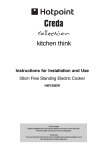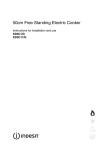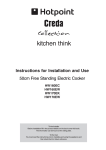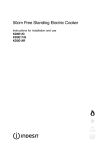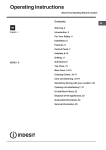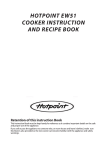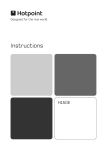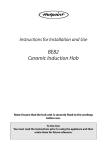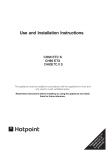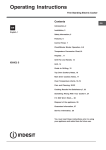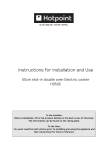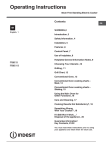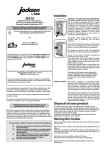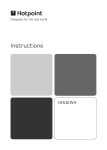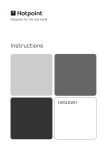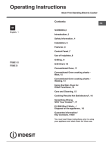Download Hotpoint HL500E User's Manual
Transcript
kitchen think Instructions for Installation and Use 50cm Free Standing Eye-level Electric Cooker HL500E To the Installer Before installation fill in the product details on the back cover this book. The information can be found on the rating plate. To the User You must read the instructions prior to installing and using the appliance and then retain them for future reference. Contents Introduction 3 Installation Safety Information 4 6 Installing the Eye-Level Grill 8 Features Control Panel 10 11 Use of hotplates 12 Hotplates General Information Notes Choosing Your Utensils 12 15 Grilling 16 Grill Chart Conventional Oven 17 18 Conventional Oven cooking charts - Meat 19 Conventional Oven cooking charts - Baking Care and Cleaning 20 21 Cooking Results Not Satisfactory? 22 Something Wrong With Your Cooker? Technical Characteristics 23 23 After Sales Service 26 Hotpoint Guarantee Key Contacts 27 Back Cover You must read these instructions prior to using your appliance and retain them for future use. 2 Introduction Your new appliance is guaranteed* and will give lasting service. This guarantee is only applicable if the appliance has been installed in accordance with the installation instructions detailed in this booklet. To help make best use of your cooking equipment, please read this booklet carefully. The cooker is designed specifically for domestic use and responsibility will not be accepted for use in any other installation. When the cooker is first used an odour may be emitted, this will cease after a period of use. When first using the cooker ensure that the room is well ventilated (e.g. open a window or use an extractor fan) and that persons who may be sensitive to the odour avoid any fumes. It is suggested that any pets be removed from the room until the smell has ceased. This odour is due to temporary finish on oven liners and elements and also any moisture absorbed by the insulation. * The guarantee is subject to the provisions that the appliance: (a) Has been used solely in accordance with the Users Instruction Book. (b) Has been properly connected to a suitable supply voltage as stated on the rating plate attached to this equipment. (c) Has not been subjected to misuse or accident or been modified or repaired by any person other than the authorised employee or agent. (d) Has been correctly installed. 3 Installation WARNING – THIS APPLIANCE MUST BE EARTHED. V Fig. A Electrical connection Electric cookers come without a power supply cable. The cooker is designed to operate on an electricity supply which conforms to the electrical data shown on the Rating Plate. The cooker can be connected to the mains only after removing the back panel of the cooker itself with a screwdriver. N.B.: the following installation procedure must be carried out by a qualified electrician. The electrical installation must comply with the IEE Regulations, Building & local By-Lays. For the installation of the feeding cable carry out the following operations: l Using a screwdriver, unscrew screw “V”(see fig. A); l Pull and open the junction blok lid Important: the wires in the mains lead are coloured in accordance with the following code: Green & Yellow Earth Blue Neutral Brown Live As the colours of the wires in the mains lead may not correspond with the coloured markings identifying the terminals in your plug, proceed as follows: Green & Yellow wire to terminal marked “E” or or coloured Green or Green & Yellow. Brown wire to terminal marked “L” or coloured Red. Blue wire to terminal marked “N” or coloured Black (see fig. B). l fix the feeding cable in the special cable stop and close the cover fastening it with the screw “V”. N.B.: the power supply cable must have these minimum requirements: Type: H05RR-F Section: 3x4 mm2 Ensure that the mains cable is routed away from any brackets affixed to the rear panel and is not trapped to the rear wall when pushing the cooker into position between cabinets. Fig. B 4 Installation The height of the cooker can be adjusted by means of adjustable feet in the plinth (900mm - 915mm). Adjust the feet by tilting the cooker from the side. Then install the product into position. NOTE: This appliance must not be fitted on a platform. The cooker is designed to fit between kitchen cabinets spaced 500mm apart. The space either side need only be sufficient to allow withdrawal of the cooker for servicing. It can be used with cabinets one side or both as well as in a corner setting. It can also be used free-standing. Adjacent side walls which project above hob level, must not be nearer to the cooker than 125mm and should be protected by heat resistant material. Any overhanging surface or cooker hood should not be nearer than 400mm. (Fig.A) Before moving your cooker check that it is cool, and switch off at the cooker control unit. 125mm Min 1850mm 1450mm 125mm Min 400mm Min Splashplate optional, apply to Parts Department (see Back Cover for contact number.) 503mm Min Fig. A 5 Safety Information When used properly your appliance is completely safe but as with any electrical product there are certain precautions that must be observed. PLEASE READ THE PRECAUTIONS BELOW BEFORE USING YOUR APPLIANCE. Always l Remove all packing from inside the oven and grill compartments before switching on for the first time. l Understand the controls prior to using the appliance. l Keep children away from the appliance when grilling as the surfaces will get extremely hot during and after use. l Turn controls off when you have finished cooking and when not in use. l Stand back when opening an oven door to allow any build up of steam or heat to disperse. l Use dry good quality oven gloves when removing items from the oven/grill. l Place pans centrally over the hotplate making sure handles are kept away from the edge of the hob and cannot become heated by other hotplate/pans. l Take care to avoid heat/steam burns when operating the controls. l Turn off the electricity supply at the wall switch before cleaning and allow the appliance to cool. l Make sure the shelves are in the correct position before switching on the oven. l Keep the oven and grill doors closed when the appliance is not in use. l Take care when removing items from the grill when the lower oven is on as the contents will be hot. l Keep the appliance clean, as a build up of grease or fat from cooking can cause a fire. l Follow the basic principles of food handling and hygiene to prevent the possibility of bacterial growth. l Keep ventilation slots clear of obstructions. l Refer servicing to a qualified appliance service engineer. l Take care to avoid touching heating elements inside the oven, as during use the oven becomes hot. l Before operating the product, remove all plastic film from the sides of the appliance. l The internal surfaces of the compartment (where present) may become hot. 6 Safety Information Never l Never line the interior of the oven with foil as this may cause the appliance to overheat. l Never leave children unsupervised where a cooking appliance is installed as all surfaces will be hot during and after its use. l Do not allow children or persons who are not familiar with the appliance to use it, without supervision. l Never allow anyone to sit or stand on any part of the appliance. l Never store items above the appliance that children may attempt to reach. l Never leave anything on the hob surface when unattended and not in use. l Never remove the oven shelves whilst the oven is hot. l Never heat up unopened food containers as pressure can build up causing the container to burst. l Never store chemicals/food stuffs, pressurised container in or on the appliance, or in cabinets immediately above or next to the appliance. l Never place flammable or plastic items on or near the hob. l Never fill a deep fat frying pan more than 1/3 full of oil, or use a lid. DO NOT LEAVE UNATTENDED WHILE COOKING. l Never use the appliance as a room heater. l Never use the grill to warm plates. l Never dry any items on either the hob or oven doors. l Never install the appliance next to curtains or other soft furnishings. l Never use steam cleaners. SAFETY ADVICE IN CASE OF A CHIP-PAN FIRE In the event of a chip pan fire or any other pan fire. 1 . TURN OFF THE COOKER APPLIANCE AT THE WALL SWITCH. 2 . COVER THE PAN WITH A FIRE BLANKET OR DAMP CLOTH, this will smother the flames and extinguish the fire. 3 . LEAVE THE PAN TO COOL FOR AT LEAST 60 MINUTES BEFORE MOVING IT. Injuries are often caused by picking up a hot pan and rushing outside with it. NEVER USE A FIRE EXTINGUISHER TO PUT OUT A PAN FIRE as the force of the extinguisher is likely to tip the pan over. Never use water to extinguish oil or fat fires. 7 Installing the Eye-Level Grill 1. Remove the product packaging. 2. Remove the rear cover protecting the Grill assembly, which is fixed in place with 6 screws (see photograph). 3. Place the Grill assembly on the left-hand side of the cooker, taking care not to scratch/damage the enamel. 4. Position the entire Grill assembly on the oven. 8 5. Fix the Grill assembly to the cooker using three screws on the right-hand side and three screws on the lefthand side as shown in the photograph, using the screws supplied. 6. Connect the 3 electric Grill wires. 7. Ensure that the wires are positioned as in figure and that the sleeving is over the bar. 8. Replace the rear cover and fix it in place using the same screws (6) as removed previously in step 3 of this procedure. 9. Connect the cooker to the ELECTRICITY network. 9 Features GRILL EYE-LEVEL GRILL/MEAT PAN WITH HANDLE AND WIRE FOOD SUPPORT 1500W 2000W 2000W 1500W CONTROL PANEL OVEN Adjustable Feet or Legs 10 Control Panel OVEN THERMOSTAT INDICATOR LIGHT PLATE INDICATOR LIGHT GRILL INDICATOR LIGHT OVEN Control Knobs GRILL LEFT FRONT PLATE LEFT REAR PLATE RIGHT REAR PLATE RIGHT FRONT PLATE The knobs for the hotplates can be rotated in either direction to provide variable heat control, the Main Oven knob can only be rotated clockwise from the Off position. Note: Always ensure that all controls are in the OFF position, when the appliance is not in use. Operating the control when the grill is in use In common with all cookers having controls sited above the grill compartment, care must be taken when setting the controls, due to hot air being emitted from the grill compartment. 11 Use of Hotplates Note: Under no circumstances should the hob be used with aluminium foil in contact with the hob sur face. The controls set the hotplates at six pre-set power levels. Each control can be used to select one of six temperature settings from a minimum at position 1 to a maximum at position 6. Before using the hot plates for the first time, you should heat them at maximum temperature for approximately 4 minutes, without any pans. During this initial stage, their protective coating hardens and reaches its maximum resistance. Hotplates General Information Notes CONTROL SETTINGS GUIDE This is provided only as a guide – settings also depend on the type of pan used and the quality of food. Knob Position Type of food 1 1 or 2 3 4 or 5 5 or 6 6 Safety requirements for deep fat frying 12 1. 2. 3. 4. To melt butter, chocolate, etc. To To To To heat food gently. keep small amounts of water simmering. heat sauces, containing egg yolks and butter. simmer: stews, meat, fish, vegetables, fruit. To heat solid and liquid foods. Keep water boiling. Thaw frozen vegetables. Make 2-3 egg omelettes. To cook foods, just above simmering. To maintain 'rolling' boil for preserve making. To seal meat and fry fish. Frying potatoes. Bringing water to the boil. Deep fat frying. Dissolve sugar for preserve making. Use a deep pan, large enough to completely cover the appropriate heating area. Never fill the pan more than one-third full of oil. Never leave oil or fat unattended during the heating or cooking period. Never try to fry too much food at a time, especially frozen food. This only lowers the temperature of the oil or fat too much, resulting in greasy food. 5 . Always dry food thoroughly before frying, and lower it slowly into the hot oil or fat. Frozen foods, in particular, will cause frothing and spitting, if added to quickly. 6 . Never heat fat, or fry, with a lid on the pan. 7 . Keep the outside of the pan clean and free from streaks of oil or fat. Hotplates General Information Notes PANS SHOULD Not be concave (bowed in) Not be convex (bowed out) Not be rimmed Not be deeply ridged Always ✓ Use good quality flat-based cookware on all electric heat sources. Always ensure pans have clean, dry bases bifore use. Ensure pans match size of heating area. Remember good quality pans retain heat well, so generally only a low or medium heat is necessary. Ensure pan handles are positioned safely and away from heat sources. Always lift pans, do not drag. Never ✗ Use gauze, metal pan diffusers, asbestos mats and stands e.g. Wok stands - they can use overheating. Use utensils with skirts or rims e.g. buckets and some kettles. Use badly dented or distorted pans. Leave an element switched on when not cooking. Cook food directly on the ceramic glass. Drag or slide utensils, along the hob surface. Always use pan lids except when frying. Deal with spillages immediately but with care. But essentially Flat 13 Hotplates General Information Notes Do Not Do not cook directly on the hob surface without a cooking utensil, as this will result in damage to the surface of the hob. Do not use the hob as a worktop surface as damage may occur to the smooth surface of the hob. Do not drag or slide utensils on the hob surface, as this will cause scratches in the surface of the hob. Do not allow a cooking utensil to come into contact with the hob surround. Do not place anything between the base of the utensil and the ceramic hob, e.g. do not use asbestos mats, aluminium or wok stand. Do not leave any utensils, food or combustible items on the hob when it is not in use. Do not place aluminium or plastic foil, or plastic containers on the hob. Do not leave the hotplates or cooking areas switched On unless they are being used. We recommend not to place large preserving pans or fish kettles across two heating areas. Do not leave utensils partly covering the heated areas. Always ensure that they are placet centrally over the heated areas and have the same diameter as the heating area used. We recommend not to use a utensil with a base diameter greater than 25cm (l0ins). Pressure cookers or other large pans should be used on the front cooking areas. Always ensure that saucepan handles are positioned safely. 14 Choosing Your Utensils Do not use utensils with rough bases. Do not use lightweight utensils with thin, distorted or uneven bases. Do not use lightweight enamelled steel utensils. Do not use cast iron utensils. Do not use utensils with recessed, scrolled or ridged bases. Do not use a utensil which has a base concavity greater than l mm as this will reduce the performance of the hob. Do not use a utensil with a convex base. Do not use glass ceramic utensils. Do not use use lightweight saucepans with plain thin copper bases on ceramic or halogen hot plates. Note: All copper pans are excellent conductors of heat, and are hard wearing and strong, but need quite a lot of care. They can be very heavy and do not usually have completely flat bases. The interiors are usually lined with a different material such as tin. A stainless steel pan with a sandwich base of aluminium and stainless steel is an excellent conductor of heat and is suitable for use on ceramic and halogen hobs, providing they are used in accordance with the saucepans manufacturers’ recommendations. Stainless steel pans with a sandwich base of aluminium and copper are excellent conductors of heat. If using stainless steel saucepans with aluminium and copper sandwich bases on ceramic and halogen hobs, the use of these pans must be in accordance with the saucepan manufacturers’ recommendations. Extra care should be taken to ensure the base of the pan and the hob is cleaned, and the hob conditioned, after each and every use, when using this type of saucepan. If these recommendations are not followed, the result will be a build up of small copper deposits on the surface of your hob which, if not cleaned after each use, will result in permanent marking of your hob. Always lift the pan from the hob, do not drag or slide across the hob surface as damage may occur. 15 Grilling CAUTION: ACCESSIBLE PARTS WILL BECOME HOT WHEN THE GRILL IS USED - CHILDREN SHOULD BE KEPT AWAY. To operate the grill proceed as follows: Grill Pan Handle l Pre-heat the grill on setting 6 for approximately 5 minutes (see chart on guide to grilling). l Food which only requires browning should be placed directly on/in the grill pan in the grill pan runner, or on the floor of the grill compartment. (the grill pan grid may be removed.) l Leave the control on setting 6 for toast, sealing and fast cooking of foods. For thicker foods requiring longer cooking turn the control to a lower setting after the initial sealing, on both sides, on setting 6. The thicker the food the lower the control should be set. l To turn off, turn the control knob fully clockwise to the symbol O DO NOT cover the grill pan or grid with aluminium foil as this can hold fat, intensify the heat and create a fire hazard. Grilling can be started from cold but for best results preheat for approximately two minutes. Most cooking is done with the heat on full, but it may be desirable to reduce it for thicker pieces of meat, fish, chicken portions or for keeping food warm. For au gratin dishes eg. Macaroni Cheese and meringue toppings eg. Baked Alaska, place the dish on the floor of the grill compartment. The base of the grill pan can be used for warming fruit garnishes on the reduced setting. NOTE: Strong detergents used in dishwashers may damage the grill pan grid finish; clean in soapy water as described in CARE AND CLEANING section. 16 Grill Chart Pre - heat the grill for 5 minutes on maximum control setting before grillino GRILL CHART Food Grill Setting Approximate Cooking time Toasting of Bread products 6 3 - 10 mins. Small cuts of meat, sausages, bacon, etc. 5-6 15 - 20 mins. Chops etc. Gammon steaks Chicken pieces 5 20 - 25 mins. Wire food support used in upturned position for chicken. Fish: fingers Whole Fillets 5 10 - 20 mins. Whole fish and fillets placed in the base of the grill pan. Fish in breadcrumbs 5 15 - 20 mins. Pre - Cooked potato products 5 15 - 20 mins. Pizzas 5 12 - 15 mins. in the base of the grill pan. Browning of food 6 8 - 10 mins. Dish placed directly on base of the grill pan and pan placed on the base of the grill compartment. The settings in the above guide have been developed to cook food successfully without excessive fat spitting and splashing. 17 Conventional Oven Oven Control Heating of the oven is achieved by turning control clockwise to the required oven temperature scale on the control panel, as recommended in the temperature charts. The main oven light will immediately come on. The thermostat light indicates that the main oven is heating. When it turns off, the temperature inside the oven has reached the setting made with the thermostat knob. At this point, the light will turn on and off as the oven maintains the temperature at a constant level. The cooking charts provided in this book are a guide only, giving approximate cooking temperatures and times. To suit personal taste and requirements, it may be necessary to increase or decrease temperatures by 10°C. The oven is fitted with two rod shelves. The oven is heated by two tubular sheathed elements located under the floor of the oven and on the oven roof, inside the cavity. It should be noted that at the end of a cooking period there may be a momentary puff of steam when the oven door is opened. This will disperse in a few seconds and is a perfectly normal characteristic of an oven with a good door seal. Oven Positions The correct positioning of food is indicated in the temperature charts. To prepare meat and poultry for roasting in your conventional oven. (a) Wipe the joint, dry well with a clean cloth, kitchen tissue etc. and weigh it. Meat which has been stored in a refrigerator should be allowed to come to room temperature for approximately 30 minutes before cook ing, and frozen meat or poultry must be completely defrosted before placing in the oven. (b) The weight of any stuffing used should be added to the oven ready weight of the meat / poultry before calculating the cooking time. (c) Place the joint in the meat pan supplied with your cooker. Small joints weighing less than 1.75kg (31/2 lbs) should be roasted in a smaller meat pan/tin - or they may be ‘pot roasted’ - a small joint in a large meat pan causes unnecessary oven splashing and evaporation of meat juices. (d) Additional fat should not be added, except for veal, very lean meat or poultry which can either be ‘larded’ with fat bacon or brushed very sparingly with cooking oil or melted fat. (e) Beef, lamb, mutton and poultry may be dusted lightly with seasoned flour to give a crisp outer surface. The skin of duck and goose should be pricked to release excess fat during cooking, and the rind of pork should be scored, brushed lightly with oil, and rubbed with salt, to give crisp crackling. (f) Potatoes for roasting only require to be brushed with cooking oil or melted fat. (g) It is not necessary to baste when roasting in an electric oven and stock or liquid should not be added to the meat pan since this only causes unnecessary soiling, steam and condensation. For optimum cooking performance, there must be clearance between meat pan and oven sides. The meat pan must be placed lengthways in the oven to allow for air circulation. Times and Temperatures for Roasting 18 The secret of succulent, tender meat, is not to roast it too quickly, at too high a temperature. Best results are obtained when roasting is carried out at a low temperature. When a lower temperature is used, the joint loses less weight, is more tender (too high a temperature causes meat to be tough and dry) and the splashing of fat onto the oven interior is reduced to a minimum. When a complete meal is being cooked in the oven, cooking time may need to be increased and temperature may need to be raised for approximately the last 30 minutes of the cooking period (for instance when cooking Yorkshire pudding to serve with roast beef ). The suggested times and temperatures should be used as a guide, but may vary according to:1 . Whether you prefer meat rare, medium or well done. 2 . The size and shape of your joint. ( a ) A short thick joint requires a longer cooking period than a long thin joint. (b) A small joint under 1.5kg (3 lbs) takes longer per 450g (1 lb) cook in the time given for ‘minutes’ per 450g (1 lb) without the ‘minutes’ over added. ( c ) Boned/rolled and stuffed joints take longer to cook through than those with a bone. Conventional Oven - Cooking Chart MEAT Note: Where times are stated, they are approximate only. Conventional Oven Meat Preheat Temperature °C Time (approx.) Beef Yes 190/200 25-30 mins per 450g (1lb) + 25 mins over. Lamb Yes 190/200 25-30 mins per 450g (1lb) + 25 mins over. Pork Yes 190/200 30-35 mins per 450g (1lb) + 30 mins over. Veal Yes 190/200 25-35 mins per 450g (1lb) + 30 mins over. Poultry/Game up to 4kg (8lb) Yes 180/190 18-20 mins per 450g (1lb) + 20 mins over. Turkey up to 5.5kg (12lb) Yes 190 22 mins per 450g (1lb) eg. 5.5 kg (11lb) = 242 mins Turkey over 5.5kg (12lb) Yes 180 18 mins per 450g (1lb) eg. 10 kg (22lb) = 352 mins Casserole Cooking Yes 140/160 2-2 ½ hrs Position in Oven In meat pan on runner 2 Runner 3 from bottom of oven Runner 3 If using aluminium foil, never: 1. Allow foil to touch sides of oven. 2. Cover oven interior with foil. 3. Cover shelves with foil. The most accurate method of testing the readiness of joints of meat or whole poultry is to insert a meat thermometer into the thickest part of a joint, or the thickest part of poultry thighs, during the cooking period. The meat thermometer will indicate when the required internal temp has been reached. Beef: Rare: Medium: Well Done: 60°C 70°C 75°C Lamb: Pork: Veal: 80°C 90°C 75°C Poultry: 90°C 19 Conventional Oven - Cooking Chart BAKING Conventional Oven Cooking Food Preheat Temperature and Time Position in Oven from bottom Scones Yes 220/230°C approx. 10-15 mins. Runners 1 & 4 Small Cakes Yes 190/200°C approx. 20-25 mins. Runners 1 & 4 Victoria Sandwich Yes 180/190°C 6½"-7" tins approx. 20 mins. 8"-8½" tins approx. 30 mins. Runners 1 & 4 Sponge Sandwich (Fatless) Yes 190/200°C 7" tins 15-20 mins. Runners 1 & 4 Swiss Roll Yes 200/210°C approx. 10-15 mins. Runner 4 Semi-rich Cakes Yes 160/170°C 61½-7" tins 1¼" -1½" hours 8"-9" tins 2"-2½" hours Runner 3 Shortcrust Pastry Yes 200/210°C depending on use Runners 2 & 5 Puff Pastry Yes 200/210°C approx. depending on use Runners 2 & 5 Yorkshire Pudding Yes 210/220°C 45-50 mins. Runner 5 Individual Yorkshire Puddings Yes 210/220°C approx. 20-25 mins. Runner 5 Milk Pudding Yes 150/160°C approx. 2"-2½" hours Runner 2 Baked Custard Yes 150/160°C approx. 45-55 mins. Runner 2 Bread Yes 230°C 50-60 mins reducing to 210/220°C 230°C 45-50 mins after first 10 minutes Runners 1 & 4 Meringues Yes 100/110°C Large3½"-4½" hours Small 2½"-3" hours Runner 2 Note: If soft margarine is used for cake making, temperatures recommended by the manufacturers should be followed. Temperatures recommended in this chart refer to cakes made with block margarine or butter only. 20 Care and Cleaning Electric sealed hotplates The cleaning of sealed hotplates should be done when they are cold, using a soap filled Brillo pad, following the grain of the hotplate. This will ensure that any stubborn, burnt on spillages are removed. Wipe over with a damp clean cloth, making sure that all the cleaner has been removed. Finally, turn on hotplate to warm for a few minutes, then smear with a little cooking oil to provide a protective coating, or the restorative agent Homecare Four Hob, available from our spares department or leading supermarkets. The bezels will mellow with use to a burnished gold colour, a soap filled Brillo pad will help to keep them bright, care should be taken not to damage the vitreous enamel hob surface. Note: We do not recommend the use of decorative covers over the hot hotplates as these can hold condensation and cause corrosion. Accidental operation with a cover in place can cause intense heat. Never place saucepan lids on the hotplates, as this may cause corrosion. Grill Remove the grill pan and the wire grid food support, it is best to wash these items immediately after use to prevent stains from being burnt on when used again. Wipe out the Grill compartment, use a fine steel wool soap pad to remove stubborn stains from the grill runners and the floor of the compartment. Wipe over the control panel with a damp cloth and polish with a dry cloth. Control Panel Do not use cream cleaners, oven cleaners or aerosols, scouring pads or abrasive powder for cleaning the plastic knobs as damage will occur. Decorative Trims It is advisable to clean the decorative trims regularly to prevent any build up of soiling. The recommended method of cleaning is to wipe over the trims with a soft cloth wrung out in warm water or mild non-abrasive cleaner. (If in doubt try the cleaner on a small area of trim which is not noticeable in normal use). Then, after wiping with a cloth wrung out in clear water, dry with a soft clean cloth. Doors Wipe over the outer door glass panels with a cloth wrung out in warm soapy water, then after wiping with a cloth wrung out in clear water, dry with a soft clean cloth. Ensure that glass doors are not subjected to any sharp mechanical blows. Glass Inner Door Panel (where fitted) – open the door fully and unscrew the two screws securing the glass panel, taking care not to allow the glass to fall. The glass panel may now be washed at the sink. Stubborn stains can be removed by using a fine steel wool soap pad. Ensure the glass panel is not subjected to any sharp mechanical blows. Take particular care not to damage the inner surface which is coated with a heat reflective layer. After cleaning, rinse and dry with a soft cloth. For slight soiling the inner glass panel may be cleaned, while still warm, without removing it from the door. Warning: Oven must not be operated with inner door glass removed. Take care during cleaning not to damage or distort the door seals. Do not lift the door seal from the oven chassis, if necessary remove the seal by carefully unhooking the corner clips. Take care that the rating label edges are not lifted during cleaning, and furthermore that the lettering is not blurred or removed. Ovens Remove the rod shelves and grill pan. Use a fine steel wool soap pad to remove stubborn stains from the rod shelves, grill pan and the floor of the oven. Clean the glass part of the oven door using a sponge and a non-abrasive cleaning product, then dry thoroughly with a soft cloth. Do not use rough abrasive material or sharp metal scrapers as these could scratch the surface and cause the glass to crack. Oven Shelf Supports The shelf supports are removable and dishwasher safe. To remove hold the support at the front and pull away from the oven side, this can then be cleaned in a sink or a dishwasher. When removed it allows access to the oven side, which can be cleaned with warm soapy water. To refit the support, insert the longer leg into the rear fixing hole and push in the front leg. Oven Lamp Replacement Open the oven door and remove the rod shelves. Using a suitable cloth to protect the fingers grip the light glass dome, unscrew anti-clockwise and lift. Reach into the aperture with fingers, and unscrew the lamp anticlockwise. Fit replacement lamp (25W 300°C rated SES), refit dome. WARNING: To avoid electric shocks - please ensure that the electricity supply to the appliance is switched off and the appliance is fully cold, before removing the lamp lens. 21 Cooking Results Not Satisfactory? Problem Check Grilling Uneven cooking front to Ensure that the grill pan is positioned centrally below back the grill element. Fat splattering Ensure that the grill is not set to too high a temperature. Oven Baking Uneven rising of cake Ensure that the oven shelves are level by using a spirit level on the rod shelf and adjusting, using suitable packing e.g. wood, under the feet of the appliance. This should be checked both left to right and front to back. Ensure that the food is positioned centrally in the oven. Sinking of cakes The following may cause cakes to sink: 1. Cooking at too high a temperature. 2. Using normal creaming method with soft margarine. Over/Under cooking Fast/Slow cooking Refer to the cooking times and temperatures given in the oven temperature charts, however, it may be necessary to increase or decrease temperatures by 10°C to suit personal taste. Do not use utensils greater than 2¼ ins in height. Uneven cooking of cakes 1. Too large baking sheet used. (See 'Cookery Notes') 2. Over loading of oven and always ensure even air gaps around baking tins. Uneven rising of cake Ensure that the shelf is level (see above) and that the food is positioned centrally in the oven. Food is taking too long to cook Only cook one item at a time to avoid overloading the oven. Disposal of your product To minimise the risk of injury to children please dispose of your product carefully and safely. Remove all doors and lids. Remove the mains cable (where fitted) by cutting off flush with the appliance and always ensure that no plug is left in a condition where it could be connected to the electricity supply. To help the environment, Local Authority instructions should be followed for the disposal of your product. This appliance conforms to the following EEC Directives: Electromagnetic Compatibility 89/336/EEC 92/31/EEC 93/68/EEC Low Voltage Equipment 2006/95/CEE 93/68/EEC The European Directive 2002/96/EC on Waste Electrical and Electronic Equipment (WEEE), requires that old household electrical appliances must not be disposed of in the normal unsorted municipal waste stream. Old appliances must be collected separately in order to optimise the recovery and recycling of the materials they contain and reduce the impact on human health and the environment. The crossed out “wheeled bin” symbol on the product reminds you of your obligation, that when you dispose of the appliance it must be separately collected. Consumers should contact their local authority or retailer for information concerning the correct disposal of their old appliance. 22 Something Wrong with your Cooker? Before contacting your nearest Service Centre/Installer, check the problem guide below; there may be nothing wrong with your cooker. Problem Slight odour or small amount of smoke when using the cooker for the first time. This is normal and should cease after a short period. Nothing Works Is the main cooker wall switch turned on? There may be no electricity supply. Oven temperature seems too high or too low. Check that the temperature has been set in accordance with the temperature charts. It may be necessary to increase or decrease the recommended temperature by up to 10°C to suit your taste. Oven does not cook evenly. Check that the temperature and shelf position are as recommended in the temperature charts. Check that the containers being used in the oven allow sufficient air flow around them. Check that the cooker is level. Hotplates are slow to boil or will not simmer Check that your pans conform to the recommendations in these instructions. Marks appearing on hotplates. Can not clean hob / hotplates. The hob surround can be cleaned with warm soapy water and a cream cleaner, such as Cif. The sealed hotplates should be cleaned regularly, (please refer to the Care and Cleaning section for further information. Please note that replacement hob cleaning kits are available from our parts department, see Key Contacts, back page. Grill not working. The grill door MUST be open. Grill keeps turning on and off. When the grill control is operated at a setting less than maximum, this is normal regulator operation, not a fault. Condensation on the wall at the rear of the cooker. Steam and/or condensation may appear from the vent at the rear of the appliance when using an oven particularly for foods with a high water content e.g. frozen chips, roast chicken etc. This is normal and any excess should be wiped off. Steam / Condensation in the oven after use. Steam is a by-product of cooking any food with a high water content. To help minimise always: a) Try to avoid leaving food in the oven to cool after being cooked. b) Use a covered container, wherever possible Technical Characteristics Main Oven Dimensions (HxWxD): 34x39x44 cm Volume: 58 Litres Max. Oven Power Absorption: 1950 W Voltage and Frequency 240V~ 50/60Hz Max. Power Absorption: 11800 W ENERGY LABEL Directive 2002/40/EC on the label of electric ovens Norm EN 50304 Declared energy consumption for Natural convection Class heating mode: Convectional 23 24 25 After Sales Service "No company is better positioned to offer an after sales service on a Hotpoint appliance than us - the manufacturer" As part of our commitment to you, all Hotpoint appliances have the added benefit of a fully inclusive parts and labour guarantee for the first 12 months. In addition to this you also have the advantage of free replacement parts for the first 5 years when fitted by a Hotpoint engineer. When the 12 months parts and labour guarantee expires we offer the following after sales service options: Repair Service and Information Help Desk UK: 08709 066066 www.theservicecentre.co.uk Republic of Ireland: 1850 302 200 Note: Our operators will require the Model number and the Serial number of your appliance Available 364 days a year with a fast, effective and value for money service. We have the largest white goods repair service in the UK with over 1200 of our own fully trained engineers. All repairs include a parts and labour guarantee for 12 months from the date of the repair. If you require any information or have any questions about your appliance, our operators are on hand with help and advice. All this ensures that you will receive the best available after sales service possible. Extended Warranties UK: 08709 088 088 www.theservicecentre.co.uk Republic of Ireland: 1850 502 200 Whether you have just one or a number of Hotpoint appliances in your kitchen, we offer two service cover plans to give you total peace of mind. l Repair Protection Plan FREE service repairs for a single Hotpoint appliance during the period of cover. FREE service repairs for all your Hotpoint appliances less than 8 l Kitchen Cover years old. Genuine Parts and AccessoriesUK: 08709 077 077 www.theservicecentre.co.uk Republic of Ireland: (01) 842 6836 A wide range of genuine parts and accessories are available from our hotline or through our web site. Genuine parts and accessories, extended warranties and service repairs are all available on our web-site at: www.theservicecentre.co.uk 26 Guarantee "Satisfaction guaranteed or your money back" We give you a unique 'satisfaction guaranteed' promise - valid for 90 days - after you have purchased your Hotpoint appliance. If there is a technical problem simply call Hotpoint Repair service or visit our web-site at www.theservicecentre.co.uk and where necessary, we will arrange for an engineer to call. If the technical problem is not resolved under this guarantee, we will replace your machine or, if you prefer, give you your money back. All Hotpoint appliances carry a fully inclusive 12 month parts and labour guarantee as well as free replacement parts for the first 5 years (except microwaves, selected integrated appliances and cooker hoods, which have a one year guarantee) provided that they are fitted by a Hotpoint engineer. Guarantee terms and conditions Your guarantee is only applicable in the United Kingdom or Republic of Ireland and is subject to the following provisions that your appliance: l Has been installed and used correctly in accordance with this instruction booklet. l Has been used solely for domestic purposes and is located on domestic premises (ie. not for commercial or trade use). l Has been properly connected to a suitable electrical supply voltage as stated on the appliance rating plate. l Has not been subject to misuse, accident, modified or repaired by anyone other than one of our own service engineers. For pre purchase information on any other Hotpoint product call: 08701 50 60 70 or visit: www.hotpoint.co.uk Recycling & Disposal Information As part of Hotpoint's continued commitment to helping the environment, Hotpoint reserves the right to use quality recycled components to keep down customer costs and minimise material wastage. Please dispose of packaging and old appliances carefully. To minimise risk of injury to children, remove the plug and cut mains cable off flush with the appliance. Dispose of these parts separately to ensure that the appliance can no longer be plugged into a mains socket. 27 Key Contacts After Sales Service Over 1200 trained specialists, directly employed by us, ensure that you can have complete confidence in both the appliances and services we offer. Repair Service and Information Desk UK: 08709 066 066 (Open 8 to 8 Mon - Fri, 8 to 6 Sat, 10 to 4 Sun & Bank Holidays) www.theservicecentre.co.uk Republic of Ireland: 1850 302 200 Note: Our operators will require the following information: Model number: Serial number: Extended Warranties UK: 08709 088 088 (Open 8 to 8 Mon - Sun) www.theservicecentre.co.uk Republic of Ireland: 1850 502 200 Genuine Parts and Accessories UK: 08709 077 077 (Open 8-30 to 5-30 Mon - Fri & 9 to 12 Sat) www.theservicecentre.co.uk Republic of Ireland: (01) 842 6836 Indesit Company UK LTD, Morley Way, Peterborough, PE2 9JB. 04/2008 - 19506499603




























